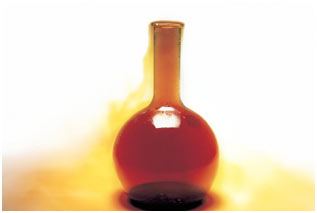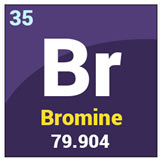Introduction
Bromine is one of the members of the halogen family which makes group VIIA of the periodic table.
- Like other halogens, its salts are quite famous and are widely used.
- Bromine has 35 electrons.
- The atomic number of bromine is 35 whereas its atomic weight is 79.
Naming and History
Bromine got its name from the Greek word “bromos” which means “stench”. This is because bromine is really stinky and has a bad and pungent odor.
History reveals that a student name Carl Lowig at Heidelberg collected bromine which he produced from saltwater near his house. His professor asked him to produce more so they could further study it.
While he was doing, the French scientist Antoine Jerome Ballard 1826 published his findings and discovery about the new elements. He passes chlorine gas through the residue of brine. Red-orange gas was released which he thought was a new element.
Occurrence of Bromine
Bromine is abundant in nature but not be found I its pure elemental form. It occurs in its salt forms such as bromide salts, in combination with other compounds and part of some rocks in Earth’s crust.
It is also present in waters rich in salts, brines, and salt lakes. The major suppliers of bromine in the world are China, Japan, Jordan, and Wales. The most common of its salts are sodium and potassium bromide.

Properties of Bromine
Bromine is the only non-metal which exists in liquid form at room temperature. It is the brownish-red liquid of pungent and stinky odor. It can easily vaporize as a red vapor at standard temperature and pressure.
Bromine in its pure elemental form is extremely hazardous and a severe irritant of the throat, eyes, and nose. It can cause injuries and severe burns to the skin. The melting point of bromine is -7.2°C and the boiling point is 58.8°C. it has a density of 3.11 grams per cubic centimeter.
It is a very reactive element but less reactive than fluorine and chlorine and can even react with platinum and palladium. It is soluble in organic compounds such as alcohols and ethers.
Bromine in Biological Systems
Bromine is almost present in all living things. In animals, a bromine cofactor is required for the formation of collagen. Although in high doses, bromine is highly toxic and can cause severe irritation to the eyes, skin, nose, and respiratory system.
Uses of Bromine
Bromine has a wide range of uses in the industry especially to prepare organobromine compounds.
These are used in making insecticides, medicines, and other pharmaceuticals such as sedatives and anticonvulsants.
Silver bromide (AgBr), a chemical used in photography, now accounts for the largest use of bromine.
Other bromine substances are used in fumigants, flameproofing agents, and in some substances used to purify water.
Tyrian purple, an expensive purple color dye known from ancient civilizations, was produced from an organic bromine compound secreted from a sea mussel known as the murex.
1,2-dibromoethane is used as an anti-knock agent to raise the octane number of gas and permit engines to run more smoothly. This application has actually declined as a result of environmental legislation.
When brominated compounds burn, hydrobromic acid is produced. The acid functions as a flame retardant by interfering with the oxidation reaction of combustion.
Calcium bromide (CaBr2), sodium bromide (NaBr), or zinc bromide (ZnBr2) are added to the wells to increase the performance of the drilling procedure.
Isotopes of Bromine
There are almost 29 known isotopes of bromine ranging from 69- Br to 79- Br. The naturally occurring two isotopes of bromine are Br- 79 with 50% abundance and Br- 81 with 49% abundance. Bromine isotopes have no known commercial use.
MCQs
- What is the atomic number of bromine?
- A) 25
- B) 35
- C) 45
- D) 55
- Answer: B
- Which group does bromine belong to in the periodic table?
- A) IV A
- B) V A
- C) VI A
- D) VII A
- Answer: D
- What is the atomic weight of bromine?
- A) 69
- B) 79
- C) 89
- D) 99
- Answer: B
- From which Greek word is the name “bromine” derived?
- A) Bromos (stench)
- B) Bromides (salts)
- C) Broma (liquid)
- D) Brousse (brown)
- Answer: A
- Who discovered bromine and how?
- A) Antoine Lavoisier, by electrolysis
- B) Carl Lowig, from saltwater
- C) Marie Curie, by radioactivity
- D) John Dalton, by atomic theory
- Answer: B
- Where is bromine abundantly found in nature?
- A) Pure elemental form
- B) Rocks
- C) Salt forms and brines
- D) Gases in the atmosphere
- Answer: C
- What is the state of bromine at room temperature?
- A) Solid
- B) Gas
- C) Liquid
- D) Plasma
- Answer: C
- What is the color of bromine in its liquid form?
- A) Clear
- B) Blue
- C) Reddish-brown
- D) Green
- Answer: C
- What is the melting point of bromine?
- A) -17.2°C
- B) -7.2°C
- C) 7.2°C
- D) 17.2°C
- Answer: B
- In what industry is silver bromide commonly used?
- A) Agriculture
- B) Photography
- C) Construction
- D) Electronics
- Answer: B
- What is the primary use of bromine in insecticides, medicines, and pharmaceuticals?
- A) Flameproofing
- B) Fumigation
- C) Water purification
- D) Organobromine compounds
- Answer: D
- Which ancient purple dye was produced from an organic bromine compound secreted by sea mussels?
- A) Royal Blue
- B) Tyrian Purple
- C) Byzantium Violet
- D) Imperial Indigo
- Answer: B
- What is the role of 1,2-dibromoethane in engines?
- A) Fuel additive
- B) Lubricant
- C) Anti-knock agent
- D) Cooling agent
- Answer: C
- What does hydrobromic acid produced during burning of brominated compounds act as?
- A) Catalyst
- B) Oxidizing agent
- C) Flame retardant
- D) Reducing agent
- Answer: C
- What is added to wells to increase the performance of the drilling procedure?
- A) Sodium chloride
- B) Calcium bromide
- C) Potassium iodide
- D) Zinc sulfide
- Answer: B
- How many naturally occurring isotopes does bromine have, and what are their abundances?
- A) 1 isotope with 100% abundance
- B) 2 isotopes with 50% and 49% abundance
- C) 3 isotopes with varying abundances
- D) 4 isotopes with equal abundances
- Answer: B
Frequently Asked Questions (FAQs) – Bromine: Occurrence, Properties, Uses & Isotopes
1. What group does bromine belong to in the periodic table?
- Answer: Bromine belongs to Group VIIA, the halogen family, in the periodic table.
2. How did bromine get its name, and why is it associated with a “stench”?
- Answer: The name “bromine” is derived from the Greek word “bromos,” meaning “stench,” due to its pungent and bad odor.
3. In what forms does bromine occur in nature?
- Answer: Bromine is abundant in nature but is not found in its pure elemental form. It occurs in salt forms, such as bromide salts, in combination with other compounds and in some rocks in Earth’s crust.
4. What are the major suppliers of bromine globally?
- Answer: China, Japan, Jordan, and Wales are among the major suppliers of bromine worldwide.
5. What is unique about the physical state of bromine at room temperature?
- Answer: Bromine is the only non-metal that exists in liquid form at room temperature, appearing as a brownish-red liquid with a pungent odor.
6. Is bromine hazardous in its pure elemental form?
- Answer: Yes, bromine in its pure elemental form is extremely hazardous, being a severe irritant to the throat, eyes, and nose, causing injuries and severe burns to the skin.
7. What are the uses of bromine in biological systems?
- Answer: Bromine is present in animals as a cofactor for collagen formation. However, in high doses, it can be highly toxic, causing irritation to various parts of the body.
8. What are some common industrial uses of bromine?
- Answer: Bromine is widely used in the industry to prepare organobromine compounds, which find applications in insecticides, medicines, and pharmaceuticals. Additionally, silver bromide in photography and various bromine substances in fumigants and flameproofing agents are common uses.
9. Which ancient dye was produced from an organic bromine compound?
- Answer: Tyrian purple, an expensive purple dye known from ancient civilizations, was produced from an organic bromine compound secreted by a sea mussel known as the murex.
10. What role does 1,2-dibromoethane play in engines?
- Answer: 1,2-dibromoethane is used as an anti-knock agent to raise the octane number of gas and permit engines to run more smoothly.
11. How does hydrobromic acid produced during burning of brominated compounds function?
- Answer: Hydrobromic acid acts as a flame retardant by interfering with the oxidation reaction of combustion.
12. What substances are added to wells to enhance drilling performance?
- Answer: Calcium bromide (CaBr2), sodium bromide (NaBr), or zinc bromide (ZnBr2) are added to wells to increase the performance of the drilling procedure.
13. How many isotopes of bromine are there, and what are the naturally occurring isotopes?
- Answer: There are almost 29 known isotopes of bromine. The naturally occurring isotopes are Br-79 (50% abundance) and Br-81 (49% abundance). However, bromine isotopes have no known commercial use.

